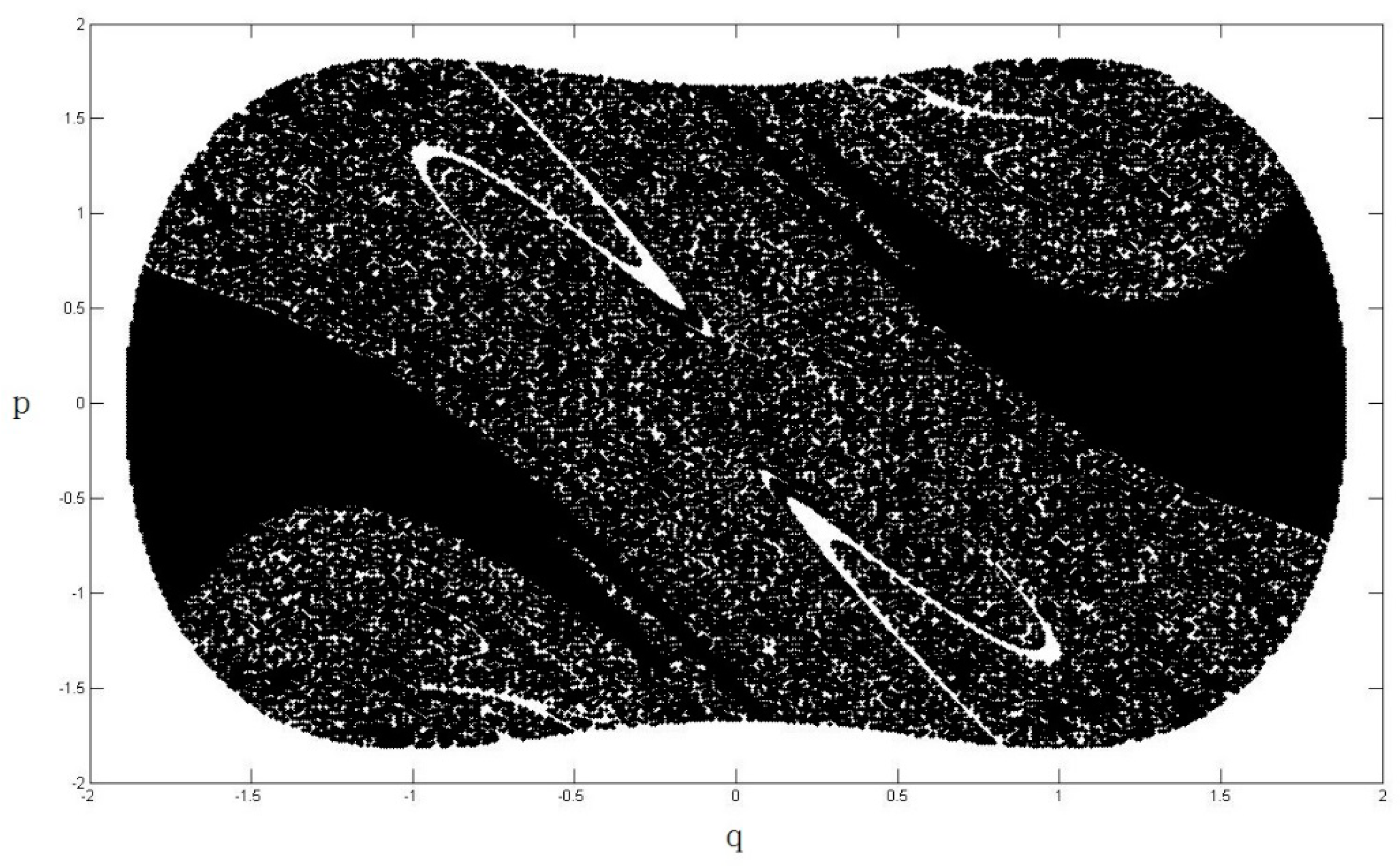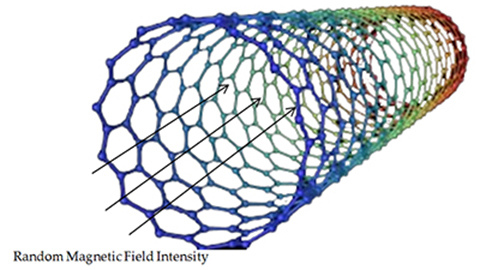Stochastic Resonance and Safe Basin of Single-Walled Carbon Nanotubes with Strongly Nonlinear Stiffness under Random Magnetic Field
Abstract
:1. Introduction
2. Strongly Nonlinear Model of Single-Walled Carbon Nanotubes
3. Nonlinear Dynamic Characteristics of Single-Walled Carbon Nanotubes
- (1)
- For small , the steady-state probability density of is the maximum which implies that the system may be stable at the original point and the system motion is a slight vibration near the balance point (0, 0) in a probability sense. With increasing , a crest occurs in the SPD map and the system motion is periodic in a probability sense which may cause system vibration and reduce the system characteristics.
- (2)
- With further increasing of , two loops occur in the SPD map. It implies that the system motion has two possible occurrences and each of them is periodic. The system response can jump from one periodic motion to another under an external excitation, which in turn causes the mutation of vibration amplitude.
- (3)
- For at a high level, a crest and a loop occur in the SPD map. It implies that the system motion has two possible occurrences, one is a small vibration near the balance point (0, 0) and the other is a periodic motion. The system response can jump from the small vibration to the periodic motion under an external excitation. The vibration amplitude of the periodic motion is large than that of the small vibration.
- (4)
- In summary, the stochastic magnetic field intensity affects significantly the system response. An increase in may lead to an increasingly unstable system and instability may by reduced with further increasing of . It implies there exists a value has the maximum influence on the system stability and it is called the stochastic resonance.
4. Safe Basin and Reliability
- (1)
- The system reliability function decreases with increasing time, which indicates that the probability of the system to stay in the safe basin becomes increasingly smaller and the probability of damage to the system increases. If the parameter is large enough, the system reliability will decrease quickly; if the parameter is small, the system reliability decreases slowly. Thus, the parameter significantly affects the system reliability.
- (2)
- The probability density of first-passage time increases with time. First-passage means that the leaving of the system from the safe area and it causes system instability. There exists a peak in the probability density of the first-passage time that corresponds to the time when the system leaves the safe basin.
5. Conclusions
Author Contributions
Acknowledgments
Conflicts of Interest
References
- Iijima, S. Helical microtubules of graphitic carbon. Nature 1991, 354, 56–58. [Google Scholar] [CrossRef]
- Lau, K.T.; Gu, C.; Hui, D. A critical review on nanotube and nanotube/nanoclay related polymer composite materials. Compos. Part B 2006, 37, 425–436. [Google Scholar] [CrossRef]
- Spitalsky, Z.; Tasis, D.; Papagelis, K.; Galiotis, C. Carbon nanotube-polymer composites: Chemistry, processing, mechanical and electrical properties. Prog. Polym. Sci. 2010, 35, 357–401. [Google Scholar] [CrossRef]
- Eringen, A.C. Nonlocal Polar Elastic Continua. Int. J. Eng. Sci. 1972, 10, 1–16. [Google Scholar] [CrossRef]
- Eringen, A.C. Linear theory of nonlocal elasticity and dispersion of plane waves. Int. J. Eng. Sci. 1972, 10, 425–435. [Google Scholar] [CrossRef]
- Romano, G.; Barretta, R. Comment on the paper “Exact solution of Eringen’s nonlocal integral model for bending of Euler-Bernoulli and Timoshenko beams” by Meral Tuna & Mesut Kirca. Int. J. Eng. Sci. 2016, 109, 240–242. [Google Scholar]
- Romano, G.; Barretta, R.; Diaco, M. On nonlocal integral models for elastic nano-beams. Int. J. Mech. Sci. 2017, 131, 490–499. [Google Scholar] [CrossRef]
- Barretta, R.; Diaco, M.; Feo, L.; Luciano, R.; Marotti de Sciarra, F.; Penna, R. Stress-driven integral elastic theory for torsion of nano-beams. Mech. Res. Commun. 2018, 87, 35–41. [Google Scholar] [CrossRef]
- Challamel, N.; Wang, C.W. The small length scale effect for a non-local cantilever beam: A paradox solved. Nanotechnology 2008, 19, 345703. [Google Scholar] [CrossRef] [PubMed]
- Li, C.; Yao, L.Q.; Chen, W.Q.; Li, S. Comments on nonlocal effects in nano-cantilever beams. Int. J. Eng. Sci. 2015, 87, 47–57. [Google Scholar] [CrossRef]
- Romano, G.; Luciano, R.; Barretta, R.; Diaco, M. Nonlocal integral elasticity in nanostructures, mixtures, boundary effects and limit behaviours. Continuum Mech. Therm. 2018, 30, 641–655. [Google Scholar] [CrossRef]
- Mahmoudpour, E.; Hosseini-Hashemi, S.H.; Faghidian, S.A. Nonlinear vibration analysis of FG nano-beams resting on elastic foundation in thermal environment using stress-driven nonlocal integral model. Appl. Math. Model. 2018, 57, 302–315. [Google Scholar] [CrossRef]
- Barretta, R.; Faghidian, S.A.; Luciano, R.; Medaglia, C.M.; Penna, R. Stress-driven two-phase integral elasticity for torsion of nano-beams. Compos. Part B 2018, 145, 62–69. [Google Scholar] [CrossRef]
- Oskouie, M.F.; Ansari, R.; Rouhi, H. Bending of Euler–Bernoulli nanobeams based on the strain-driven and stress-driven nonlocal integral models: A numerical approach. Acta Mech. Sinica-PRC 2018, 1, 1–29. [Google Scholar] [CrossRef]
- Lim, C.W.; Yang, Q. Nonlocal thermal-elasticity for nanobeam deformation: Exact solutions with stiffness enhancement effects. J. Appl. Phys. 2011, 110, 013514. [Google Scholar] [CrossRef]
- Yang, X.D.; Lim, C.W. Nonlinear vibrations of nano-beams accounting for nonlocal effect using a multiple scale method. Sci. China Ser. E 2009, 52, 617–621. [Google Scholar] [CrossRef]
- Reddy, J.N. Nonlocal nonlinear formulations for bending of classical and shear deformation theories of beams and plates. Int. J. Eng. Sci. 2010, 48, 1507–1518. [Google Scholar] [CrossRef]
- Kiani, K.; Mehri, B. Assessment of nanotube structures under a moving nanoparticle using nonlocal beam theories. J. Sound Vib. 2010, 329, 2241–2264. [Google Scholar] [CrossRef]
- Li, R.; Kardomateas, G.A. Thermal buckling of multi-walled carbon nanotubes by nonlocal elasticity. ASME J. Appl. Mech. 2007, 74, 399–405. [Google Scholar] [CrossRef]
- Amara, K.; Tounsi, A.; Mechab, I.; Adda-Bedia, E.B. Nonlocal elasticity effect on column buckling of multiwalled carbon nanotubes under temperature field. Appl. Math. Model. 2010, 34, 3933–3942. [Google Scholar] [CrossRef]
- Pradhan, S.C.; Reddy, G.K. Buckling analysis of single walled carbon nanotube on Winkler foundation using nonlocal elasticity theory and DTM. Comput. Mater. Sci. 2011, 50, 1052–1056. [Google Scholar] [CrossRef]
- Ansari, R.; Torabi, J. Numerical study on the buckling and vibration of the functionally graded carbon nanotube-reinforced composite conical shells under axial loading. Compos. Part B 2016, 95, 196–208. [Google Scholar] [CrossRef]
- Xia, W.; Wang, L. Vibration characteristics of fluid-conveying carbon nanotubes with curved longitudinal shape. Comput. Mater. Sci. 2010, 49, 99–103. [Google Scholar] [CrossRef]
- Murmu, T.; Adhikari, S. Nonlocal vibration of carbon nanotubes with attached buckyballs at tip. Mech. Res. Commun. 2011, 38, 62–67. [Google Scholar] [CrossRef]
- Ghavanloo, E.; Rafiei, M.; Daneshmand, F. In-plane vibration analysis of curved carbon nanotubes conveying fluid embedded in viscoelastic medium. Phys. Lett. A 2011, 375, 1994–1999. [Google Scholar] [CrossRef]
- Lee, H.L.; Chang, W.J. Dynamic modelling of a single-walled carbon nanotube for nanoparticle delivery. Proc. R. Soc. Lond. Ser. A 2010, 467, 860–868. [Google Scholar] [CrossRef]
- Simsek, M. Vibration analysis of a single-walled carbon nanotube under action of a moving harmonic load based on nonlocal elasticity theory. Physica E 2010, 43, 182–191. [Google Scholar] [CrossRef]
- Kiani, K. Vibration analysis of two orthogonal slender single-walled carbon nanotubes with a new insight into continuum-based modeling of Van der Waals forces. Compos. Part B 2015, 73, 72–81. [Google Scholar] [CrossRef]
- Ansari, R.; Gholami, R.; Rouhi, H. Vibration analysis of single-walled carbon nanotubes using different gradient elasticity theories. Compos. Part B 2012, 43, 2985–2989. [Google Scholar] [CrossRef]
- Ke, L.L.; Xiang, Y.; Yang, J.; Kitipornchai, S. Nonlinear free vibration of embedded double-walled carbon nanotubes based on nonlocal Timoshenko beam theory. Comput. Mater. Sci. 2009, 47, 409–417. [Google Scholar] [CrossRef]
- Yang, J.; Ke, L.L.; Kitipornchai, S. Nonlinear free vibration of single-walled carbon nanotubes using nonlocal Timoshenko beam theory. Physica E 2010, 42, 1727–1735. [Google Scholar] [CrossRef]
- Fang, B.; Zhen, Y.X.; Zhang, C.P.; Tang, Y. Nonlinear vibration analysis of doublewalled carbon nanotubes based on nonlocal elasticity theory. Appl. Math. Model. 2013, 37, 1096–1107. [Google Scholar] [CrossRef]
- Simsek, M. Large amplitude free vibration of nanobeams with various boundary conditions based on the nonlocal elasticity theory. Compos. Part B 2014, 56, 621–628. [Google Scholar] [CrossRef]
- Soltani, P.; Saberian, J.; Bahramian, R.; Farshidianfar, A. Nonlinear free and forced vibration analysis of a single-walled carbon nanotube using shell model. Int. J. Fund. Phys. Sci. 2011, 1, 47–52. [Google Scholar]
- Manevitch, L.I.; Smirnov, V.V.; Strozzi, M.; Pellicano, F. Nonlinear optical vibrations of single-walled carbon nanotubes. Int. J. Nonlin. Mech. 2017, 94, 351–361. [Google Scholar] [CrossRef]
- Ouakad, H.M.; Younis, M.I. Nonlinear Dynamics of Electrically Actuated Carbon Nanotube Resonators. J. Comput. Nonlinear Dyn. 2009, 5, 011009. [Google Scholar] [CrossRef]
- Savvas, D.; Stefanou, G.; Padadopoulos, V.; Papadrakakis, M. Effect of waviness an orientation of carbon nanotubes on random apparent material properties and RVE size of CNT reinforced composites. Compos. Struct. 2016, 152, 870–882. [Google Scholar] [CrossRef]
- Jhang, S.H. Analysis of random telegraph noise observed in semiconducting carbon nanotube quantum dots. Synth. Met. 2014, 198, 118–121. [Google Scholar] [CrossRef]
- Papageorgiou, D.G.; Tzounis, L.; Papageorgiou, G.Z.; Bikiaris, D.; Chrissafis, K. b-nucleated propylene-ethylene random copolymer filled with multi-walled carbon nanotubes: Mechanical, thermal and rheological properties. Polymer 2014, 55, 3758–3769. [Google Scholar] [CrossRef]
- Xu, J.; Zhang, W.; Zhu, Z. Stochastic stability and bifurcation characteristics of multiwalled carbon nanotubes-absorbing hydrogen atoms subjected to thermal perturbation. Int. J. Hydrogen Energy 2015, 40, 12880–12888. [Google Scholar] [CrossRef]
- Tarlton, T.; Brown, J. A stochastic approach towards a predictive model on charge transport properties in carbon nanotube composites. Compos. Part B 2016, 100, 56–67. [Google Scholar] [CrossRef]
- Chang, T.P. Nonlinear thermal-mechanical vibration of flow-conveying doublewalled carbon nanotubes subjected to random material property. Microfluid. Nanofluidics 2013, 15, 219–229. [Google Scholar] [CrossRef]
- Chang, T.P. Nonlinear vibration of single-walled carbon nanotubes with nonlinear damping and random material properties under magnetic field. Compos. Part B 2017, 114, 69–79. [Google Scholar] [CrossRef]
- Wang, Y.Z.; Li, F.M. Nonlinear free vibration of nanotube with small scale effects embedded in viscous matrix. Mech. Res. Commun. 2014, 60, 45–51. [Google Scholar] [CrossRef]
- Hajigeorgiou, P.G. An extended Lennard-Jones potential energy function for diatomic molecules: Application to ground electronic state. J. Mol. Spectrosc. 2010, 263, 101–110. [Google Scholar] [CrossRef]
- Fuller, A.T. Analysis of nonlinear stochastic systems by means of the Fokker-Planck equation. Int. J. Control 1969, 9, 603–655. [Google Scholar] [CrossRef]









© 2018 by the authors. Licensee MDPI, Basel, Switzerland. This article is an open access article distributed under the terms and conditions of the Creative Commons Attribution (CC BY) license (http://creativecommons.org/licenses/by/4.0/).
Share and Cite
Xu, J.; Li, C.; Li, Y.; Lim, C.W.; Zhu, Z. Stochastic Resonance and Safe Basin of Single-Walled Carbon Nanotubes with Strongly Nonlinear Stiffness under Random Magnetic Field. Nanomaterials 2018, 8, 298. https://doi.org/10.3390/nano8050298
Xu J, Li C, Li Y, Lim CW, Zhu Z. Stochastic Resonance and Safe Basin of Single-Walled Carbon Nanotubes with Strongly Nonlinear Stiffness under Random Magnetic Field. Nanomaterials. 2018; 8(5):298. https://doi.org/10.3390/nano8050298
Chicago/Turabian StyleXu, Jia, Chao Li, Yiran Li, Chee Wah Lim, and Zhiwen Zhu. 2018. "Stochastic Resonance and Safe Basin of Single-Walled Carbon Nanotubes with Strongly Nonlinear Stiffness under Random Magnetic Field" Nanomaterials 8, no. 5: 298. https://doi.org/10.3390/nano8050298
APA StyleXu, J., Li, C., Li, Y., Lim, C. W., & Zhu, Z. (2018). Stochastic Resonance and Safe Basin of Single-Walled Carbon Nanotubes with Strongly Nonlinear Stiffness under Random Magnetic Field. Nanomaterials, 8(5), 298. https://doi.org/10.3390/nano8050298





